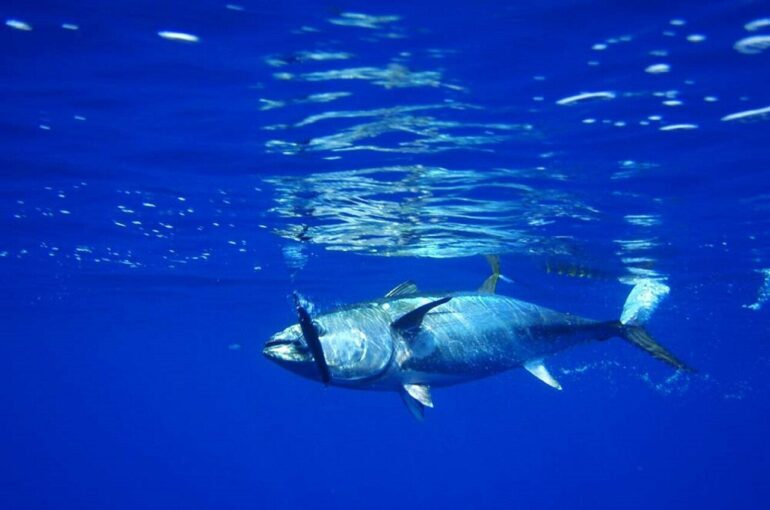A cross-border science collaboration has yielded a global database that will help researchers understand how climate change is affecting ocean predators like the albacore tuna—which also happens to be an important food source for people around the world.
“Climate change is shifting where species can live, and the pace of change is most intense in the ocean,” says Stephanie Green, associate professor in the Department of Biological Sciences and Canada Research Chair in Aquatic Global Change Ecology and Conservation.
“Our big questions are where will marine species go, and what will it mean for communities that rely on the fisheries they support?”
To tackle these questions, researchers at the University of Alberta are collaborating with colleagues in the United States to discover how top predators will respond to climate extremes and changing prey over the coming decades.
Wind and currents in the Pacific Ocean make the west coast of Canada and the United States an attractive feeding ground for migrating predators like tuna, where they support lucrative fisheries and also a hotbed of climate impacts.
The team honed in on albacore tuna, a torpedo-shaped predator known to eat hundreds of different species around the world and whose harvest is regulated by a treaty between the United States and Canada.
Diverse diet—but similar traits
The buffet of prey albacore consume makes it tough for scientists to predict where their populations will go as climate change worsens. To address this challenge, the science team shone a different light on the snacking habits of this ocean predator by looking at the common characteristics or traits of the foods they eat.
“Just like we choose foods based on what we like—be it a salty pretzel or sweet, crunchy apple—ocean predators make decisions based on the characteristics of the prey they are faced with,” says Green.
To figure out what traits are important to ocean predators, the researchers created a database categorizing more than 30 traits including fat and protein content, shape, color, size, and behaviors that make ocean species potentially tasty to predators, including albacore tuna.
“Our goal is to understand better when and where the most desirable prey will be found as the climate changes,” says Green.
“What we’re finding is that albacore tuna are quite adaptable; from among the hundreds of species they could eat, they seek out prey that have all the characteristics they prefer and focus on them,” explains research associate and study lead author Miram Gleiber.
Through the use of trait-based studies, the group hopes to create a new way to understand how ocean predators are adapting to the impacts of climate change.
Big data, open for ocean discovery
Oceans cover more than 70 percent of the planet yet are less explored than space. The research team, including seven U of A students, put in more than 10,000 hours to generate 155,000 unique pieces of information on the traits of 521 species of fish, crustaceans, squids, octopuses, and more found in ocean environments.
While many species are important prey for top predators like tunas, sharks, salmon and many others in ocean systems worldwide, other animals the team documented are known only from a handful of specimens.
The trait database is also available for international scientists to support learning about how systems are changing, Green notes.
“Large datasets like this one are created to support statistical models that look at the distribution of ocean species and how interactions between ocean species, such as between predators and their prey, might look in the future.”
“We’re getting lots of interest from scientists elsewhere who are using the information we’ve gathered, which is really exciting and rewarding for us to see,” says Natasha Hardy, a research associate who led the global diet synthesis.
Outlook for the oceans
The influence of climate change on ecosystems is complex, including more extreme weather events like heat waves that drastically alter marine environments. Marine heat waves are masses of superheated water, many degrees warmer than normal, that form in the ocean, disrupting the natural cycle that species in the ocean rely on for tracking their food, spawning, and migrating.
“Scientists are finding some species hundreds of miles from where we’ve ever seen them before, and that’s likely wreaking havoc on the system,” says project co-lead Larry Crowder, a professor at Stanford University’s Hopkins Marine Science Center.
Some species are mobile and can adapt to changing environments, but many live close to the edge of the ranges in temperature, acidity, and other stressors they can endure, causing some species to lose entire habitats, Crowder says.
The findings are published in the journal Scientific Data.
More information:
Miram R. Gleiber et al, The Pelagic Species Trait Database, an open data resource to support trait-based ocean research, Scientific Data (2024). DOI: 10.1038/s41597-023-02689-9
Provided by
University of Alberta
Citation:
Research reveals traits that make fish prey tasty to tuna (2024, March 7)


